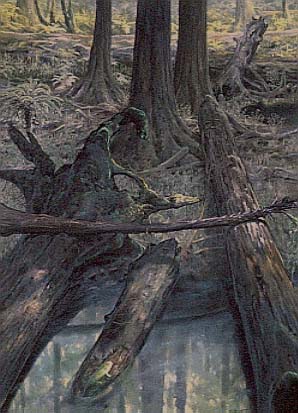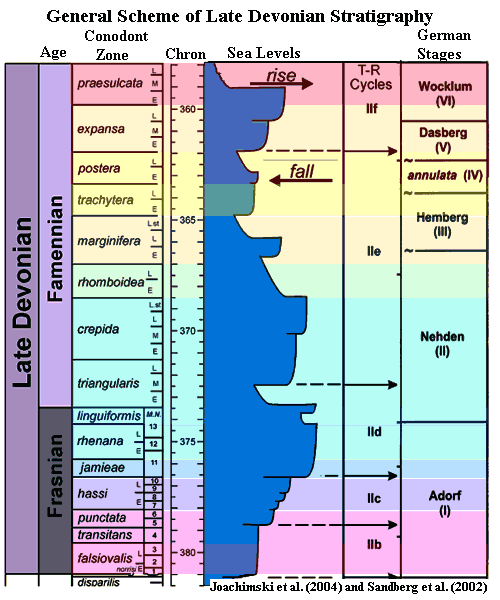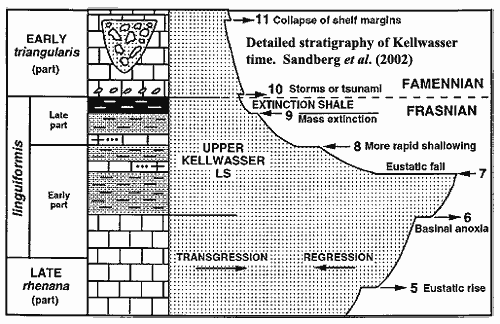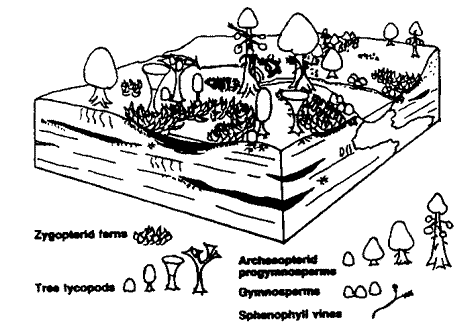The Late Devonian
The Late Devonian Epoch of the Devonian Period: 385 to 359 million years ago

Archaeopteris forests
generated shelter, shade, and nutrients (in the form of small animals and
invertebrates) that provided an ideal environment for the early tetrapodomorphs, thus leading to the
vertebrate conquest of land and the
evolution of land animals (including, eventually, us).
 Late
Devonian stratigraphy has been intensively studied; and there seems to be
considerable agreement on basics, particularly for the Euramerican world.
The disagreement there is on what it means. The attached scheme is taken
from Joachimski et al.
(2004) and Sandberg et
al. (2002). We have not tracked down each of the conodonts
for which the conodont zones are named. However, they are almost all
species of Palmatolepis. The exceptions are the Mesotaxis
falsiovalis Zone (earliest Frasnian) and the Siphonodella praesulcata
Zone (latest Famennian). Some variations in the conodont nomenclature are
also found. Thus, the postera Zone is sometimes referred to as the styriacus
Zone. The "costatus Zone" is also frequently
mentioned. This corresponds (probably) with the upper half of the expansa
Zone. Kaiser et al.
(2004).
Late
Devonian stratigraphy has been intensively studied; and there seems to be
considerable agreement on basics, particularly for the Euramerican world.
The disagreement there is on what it means. The attached scheme is taken
from Joachimski et al.
(2004) and Sandberg et
al. (2002). We have not tracked down each of the conodonts
for which the conodont zones are named. However, they are almost all
species of Palmatolepis. The exceptions are the Mesotaxis
falsiovalis Zone (earliest Frasnian) and the Siphonodella praesulcata
Zone (latest Famennian). Some variations in the conodont nomenclature are
also found. Thus, the postera Zone is sometimes referred to as the styriacus
Zone. The "costatus Zone" is also frequently
mentioned. This corresponds (probably) with the upper half of the expansa
Zone. Kaiser et al.
(2004).
This arrangement has been correlated with
strata from northern Europe and the Western United States. However, it is
not clear whether it can be successfully applied to Gondwana lands.
Critical points, such as the Frasnian - Famennian boundary and the base of the
Carboniferous, have proven very hard to identify in (for example) Eastern
Australia, Antarctica, and Africa. Kaiser et al. (2004). So, the Late Devonian may not be quite so neatly laid
out as the figure might suggest.
Note also that the chronological portion of the chart
is no longer consistent with ICS dating. You can get a reasonable
approximation of the current ICS dates in the Famennian simply by adding 1 My to
the ages on the chart. Things may not be so simple for the Frasnian.
The precision and world-wide
correlation of this arrangement are of some interest because Sandberg and others
have aggressively argued for a strong extraterrestrial influence over events in
this epoch, as well as for an Ice Age, or actually several ice ages, covering
all of the Famennian. This dramatic reading of the Late Devonian is almost
entirely based on a close reading of strata and faunal lists from northern
Baltica and western Laurentia, without so much as a dropstone or tektite (at a
relevant time) to back it up.
Whatever value their hypotheses may
have, these workers have given us a very close and detailed look at the sequence
of events in two, well- separated regions of Euramerica, and that is something
very much worth knowing. Briefly summarized, the story goes like this.
The
Frasnian was a time of rising seas. This is normally a good thing for
life. However, as in parts of the Mesozoic, sometimes the sea rises so
rapidly that the reefs are unable to keep up. When this happens,
near-shore communities may "drown" for various reasons: because benthic autotrophs find
themselves below the level where
 they can receive enough sunlight to survive, or
because of unsuitable substrate, sedimentation, or grade. With the productive base of the food chain gone, the entire
community may collapse. Such an event may have occurred in the rhenana
Zone, or perhaps the jamiae (at the beginning of transgression cycle
IId), as evidenced by the invasion of the normally pelagic conodont, Palmatolepis
semichatovae, into near-shore waters and perhaps the appearance of anoxic
bottom muds.
they can receive enough sunlight to survive, or
because of unsuitable substrate, sedimentation, or grade. With the productive base of the food chain gone, the entire
community may collapse. Such an event may have occurred in the rhenana
Zone, or perhaps the jamiae (at the beginning of transgression cycle
IId), as evidenced by the invasion of the normally pelagic conodont, Palmatolepis
semichatovae, into near-shore waters and perhaps the appearance of anoxic
bottom muds.
In the succeeding linguiformis Zone, the sea fell, recovered, and then fell precipitously and for an extended
period. This is the time of the Frasnian-Famennian extinction or
Kellwasser Event. The Kellwasser was devastating to marine life
on a specific or generic level, but had little effect on higher taxa. In short, it
was less a mass extinction than a mass turnover. The Kellwasser Event
appears to be spread over occur a significant length of time, terminating in a
black "extinction" layer followed, in some locations, by evidence of
severe disturbances which seem to indicate storm or tsunami effects.
Particularly
in view of the lack of more global sampling, it is hard to put a definite
interpretation on this this data, and we will not attempt to do so. The
Kellwasser Event was followed by generally falling sea levels in the Famennian,
punctuated by reversals, particularly towards the end of the Age. Sandberg
et al. (2002) ascribe this pattern to polar glaciation interrupted by
interglacials. Again, absent more direct evidence of a Late Devonian ice
age, we are reluctant to go so far.
ATW050113. Minor
revisions ATW050612. Text public
domain. No rights reserved.
Late Devonian Life
Extinction of coral reefs
About the middle of the Late Devonian epoch, towards the end of the Frasnian
epoch, worldwide environmental changes, including anoxia (lack of oxygen
in the oceans, perhaps the result of algal blooms) and a sudden drop in
sea level (drying up the shallow seas where life thrived, and the replacement
of a mild maritime climate with a harsh continental one ), caused one of
the greatest mass extinctions in the history of life. The victims
included many important marine organisms, and especially reef
biota. The previously flourishing reefs were decimated.
The long association between algae, sponges, stromatoporoids, and corals
that began in Ordovician times and had continued for some 130 million years
without significant disturbance came to a sudden end.

Plants: Lycopsids
included some of the stems were of diameter and their bark superficially
resembled that of Carboniferous tree-lycopsids, implying that some, such
Protolepidodendropsis, were a few metres high, and by the end of the period the group included substantial forms such as Cyclostigma.
Links between the evolution of land plants, weathering processes, and marine anoxic
events
"The Devonian Period was characterized by major changes in
both the terrestrial biosphere e g the evolution of trees and seed plants
and the appearance of multi-storied forests, and in the marine biosphere
an extended biotic crisis that decimated tropical marine benthos, especially
the stromatoporoid tabulate coral reef community. The connections between
these terrestrial and marine events are poorly understood but a key may
lie in the role of soils as a geochemical interface between the lithosphere
and atmosphere/hydrosphere, and the role of land plants in mediating weathering processes at this interface. The effectiveness of terrestrial floras
in weathering was significantly enhanced as a consequence of increases
in the size and geographic extent of vascular land plants during the Devonian.
In this regard, the most important palaeobotanical innovations were (1)
arborescence tree stature), which increased maximum depths of root penetration
and rhizoturbation [see diagram below], and (2) the seed habit, which freed
land plants from reproductive dependence on moist lowland habitats and
allowed colonization of drier upland and primary successional areas. These developments
resulted in a transient intensification of pedogenesis (soil
formation) and to large increases in the thickness and areal extent of
soils. Enhanced chemical weathering may have led to increased riverine
nutrient fluxes that promoted development of eutrophic conditions in epicontinental
seaways, resulting in algal blooms, widespread bottom water anoxia, and
high sedimentary organic carbon fluxes. Long-term effects included drawdown
of atmospheric pCO2 and global cooling leading to a brief Late
Devonian glaciation, which set the stage for icehouse conditions during
the Permo-Carboniferous. This model provides a framework for understanding
links between early land plant evolution and coeval marine anoxic and biotic
events, but further testing of Devonian terrestrial-marine teleconnections
is needed."
Thomas J. Algeo and Stephen E. Scheckler, "Terrestrial-marine
teleconnections in the Devonian: links between the evolution of land plants,
weathering processes, and marine anoxic events", Phil. Trans. R. Soc. Lond.
B (1998) 353 113-130

earlier<-------------------------->later
increasing terrestrial plant root depth penetration with time during the Devonian, leading to increasing soil depth and weathering.
rhy=rhyniophytes such as Aglaophyton or Horneophyton; tri=trimerophytes such as Psilophyton; lyc-he = early herbaceous lycopsids such as Asteroxylon or Drepanophycus; lyc.tr=early tree lycopsids such as Lepidosigillaria or Cyclostigma; prog-ao=aneurophyte Progymnosperms such as Tetraxylopteris; prog-arc=Archaeopteris progymnosperms; gym=early gymnosperms such as Elkinsia or Moresnetia; and Zyg=zygopierid ferns such as Rhacophyton. Scale bar, 1 meter.
The Late Devonian period marked the time when the first tetrapods animals evolved from their
sarcopterygian ancestors. There were at least two successive and distinct waves of
tetrapodomorph evolution, the Frasnian
Elpistostegalians, which seem to have been exterminated by the
Frasnian-Famennian extinction event, and the Famennian tetrapods (such as Acanthostega and Ichthyostega) which were to become the ancestors of the
Carboniferous labyrinthodonts. These
tetrapods were almost entirely aquatic, although they were clearly able to crawl up on the mud and move about out of water. The first
tetrapod skeletons are known from the
Late Devonian of Greenland, but other traces of Devonian fossil evidence, such as some tetrapod footprints and fragmentary remains from Australia, hint at a much greater distribution of Devonian
tetrapods than is currently revealed in the fossil record.

 Murderous
Trees
Murderous
Trees
 Developing
a Sequence Stratigraphic Framework for the Late Devonian Chattanooga Shale
of the southeastern US - "The Late Devonian Chattanooga
Shale of Tennessee and Kentucky is in most areas a thin black shale deposit
of less than 10 meters thickness. It is a distal equivalent to the almost
3000m thick Catskill sequence, and encompasses most of the Frasnian and Famennian, approximately 14 million years of earth history."
Developing
a Sequence Stratigraphic Framework for the Late Devonian Chattanooga Shale
of the southeastern US - "The Late Devonian Chattanooga
Shale of Tennessee and Kentucky is in most areas a thin black shale deposit
of less than 10 meters thickness. It is a distal equivalent to the almost
3000m thick Catskill sequence, and encompasses most of the Frasnian and Famennian, approximately 14 million years of earth history."
 Devonian times - going upstream
Devonian times - going upstream
 "Brachiopod
faunal extinction and recovery during the Frasnian-Famennian biotic crisis"
Number 04 (April) 1999, Volume 47 of Przegl?d Geologiczny (Geological Review) Polish Geological Institute
"Brachiopod
faunal extinction and recovery during the Frasnian-Famennian biotic crisis"
Number 04 (April) 1999, Volume 47 of Przegl?d Geologiczny (Geological Review) Polish Geological Institute
 The Late Devonian Mass Extinction (The Critical Moments and Perspectives in Paleobiology and Earth History Series)
by George R. McGhee, Jr. - a book about the Frasnian-Famennian extinction
The Late Devonian Mass Extinction (The Critical Moments and Perspectives in Paleobiology and Earth History Series)
by George R. McGhee, Jr. - a book about the Frasnian-Famennian extinction
images not loading? | error messages? | broken links? | suggestions? | criticism?


 Late
Devonian
Late
Devonian  they can receive enough sunlight to survive, or
because of unsuitable substrate, sedimentation, or grade. With the productive base of the food chain gone, the entire
community may collapse. Such an event may have occurred in the rhenana
Zone, or perhaps the jamiae (at the beginning of transgression cycle
IId), as evidenced by the invasion of the normally pelagic conodont, Palmatolepis
semichatovae, into near-shore waters and perhaps the appearance of anoxic
bottom muds.
they can receive enough sunlight to survive, or
because of unsuitable substrate, sedimentation, or grade. With the productive base of the food chain gone, the entire
community may collapse. Such an event may have occurred in the rhenana
Zone, or perhaps the jamiae (at the beginning of transgression cycle
IId), as evidenced by the invasion of the normally pelagic conodont, Palmatolepis
semichatovae, into near-shore waters and perhaps the appearance of anoxic
bottom muds.
